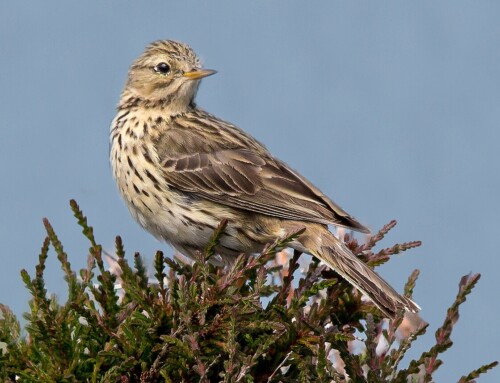How should we manage UK moorlands for birds?
LINKED PAPERS
Quantifying the importance of multi-scale management and environmental variables on moorland bird abundance. Buchanan, G.M., Pearce-Higgins, J.W., Douglas, D.J.T. & Grant, M.C. 2017. IBIS.
DOI: 10.1111/ibi.12488. VIEW
Changes in upland bird abundances show associations with moorland management. Douglas, D.J.T., Beresford, A., Selvidge, J., Garnett, S., Buchanan, G.M., Gullett, P. & Grant, M.C. 2017. Bird Study.
DOI: 10.1080/00063657.2017.1317326. VIEW
Across the globe, montane habitats are recognised as being at risk. The UK uplands, while perhaps not the highest and most mountainous regions, are nonetheless important habitats. Moorlands, which form a large part of UK uplands, comprise of unenclosed bog, heath, and grassland. Where management exists in these semi-natural habitats, it is generally for a mixture of grazing, game shooting, and nature conservation although large areas have been afforested in the past. The upland bird communities that breed in these areas are of international importance yet many species have suffered recent declines in their numbers and range.
Reversing these declines requires a better understanding of why bird abundances vary across the uplands, and how birds respond to management interventions. Along with other organisations, RSPB have considered the relationships between bird abundances and management, for example the effects of predator control (for game shooting), burning and cutting heather (for game or grazing) and grazing (which affects vegetation composition and structure). Understanding these relationships and the effects of landscape management and underlying environmental characteristics in determining abundance are fundamental to informing what management is best where.
Two recent papers from the RSPB Centre for Conservation Science make a major contribution to this understanding and here we discuss the results of these two papers. One paper by Graeme Buchanan and colleagues was published in IBIS and the other, led by David Douglas and co-authors appears in Bird Study.
The first of these was initially presented at the 2014 British Ornithologists’ Union Annual Conference: Ecology and conservation of birds in upland and alpine habitats. The study used data collected from over 150 sites across 4 regions in the UK. These data were used to measure the relative importance of within-site management (an index of predator control and vegetation composition and structure as a measure of grazing pressure), wider landscape land use (surrounding forestry and semi-improved pasture) and underlying environmental and climatic measures (climate, topography, soil) in explaining variation in breeding bird abundance. This is an important step in informing, for each species, which of the covariates have the greatest influence on abundance. This can be used to inform management: which interventions birds are most likely to respond to, and where. We could not have undertaken this study without access to these areas, and we are very grateful to the owners for allowing us to count breeding birds and survey vegetation on these plots.
Analyses indicated that the abundance of Red Grouse Lagopus lagopus scotica and waders such as Golden Plover Pluvialis apricaria was higher where an index of predator control intensity for game management was also higher. Vegetation characteristics produced as a result of local management (grazing pressure) were of very similar importance to predator control for these species. For passerines, vegetation characteristics were the more important determinant of the abundance. Wider landscape management was of low importance in determining abundances. Importantly, because abundance of some species also varied in relation to underlying physical characteristics such as slope, the analysis also highlighted the need to target conservation management to areas where physical characteristics are most suitable. Interventions such as agri-environment schemes in less suitable areas might have limited value. We now have a much clearer idea of the importance of management types, and what to do in appropriate locations. This should ensure money is not wasted undertaking management in inappropriate locations.

The second paper highlights the value of collecting long-term monitoring data, in this case a study between 1999 and 2013 of breeding bird responses to moorland management interventions at the Geltsdale reserve in Cumbria. This site is co-owned by RSPB and the Weir Trust and is a key site for RSPB’s upland conservation and advocacy. Between 1999 and 2013, grazing pressure was reduced in response to wider concerns that high sheep grazing pressure in the uplands was detrimental for habitats and the birds that rely on them. The use of moorland burning and cutting to manage vegetation were also examined. Golden Plover, Eurasian Curlew Numenius arquata, Northern Wheatear Oenanthe oenanthe and Eurasian Skylark Alauda arvensis responded positively to management that is likely to create shorter vegetation (burning/cutting or grazing). For species such as Golden Plover and Northern Wheatear this is consistent with what we know about their habitat preferences from previous studies. Conversely, Whinchat Saxicola rubetra responded positively to increasingly dense vegetation at the ground layer.
The results of both studies highlight that different bird species respond to different management interventions and environmental conditions. Therefore, planning may be required to deliver a mix of habitat types (composition and structure) with varying levels of predator control that optimises the potential benefits for multiple species. Previous experience in lowland farmland environments has shown that these types of study provide the evidence base upon which agri-environment schemes are based. These schemes encourage farmers to deliver particular management options that will benefit wildlife and the environment. Incorporation of the results of these two studies into the design of agri-environment schemes for moorland habitats is essential if these schemes are to actually deliver benefit for avian conservation.
References
Buchanan, G.M., Pearce-Higgins, J.W., Douglas, D.J.T. & Grant, M.C. 2017. Quantifying the importance of multi-scale management and environmental variables on moorland bird abundance. IBIS. DOI: 10.1111/ibi.12488. VIEW
Douglas, D.J.T., Beresford, A., Selvidge, J., Garnett, S., Buchanan, G.M., Gullett, P. & Grant, M.C. 2017. Changes in upland bird abundances show associations with moorland management. Bird Study. DOI: 10.1080/00063657.2017.1317326. VIEW
Image credit
Featured image: Golden Plover Pluvialis apricaria © Andy Hay/RSPB
If you want to write about your research in #theBOUblog, then please see here.





